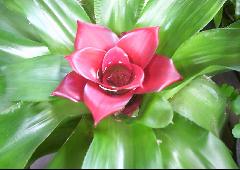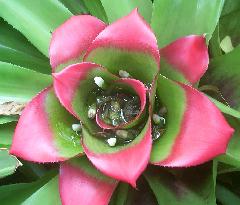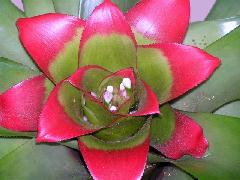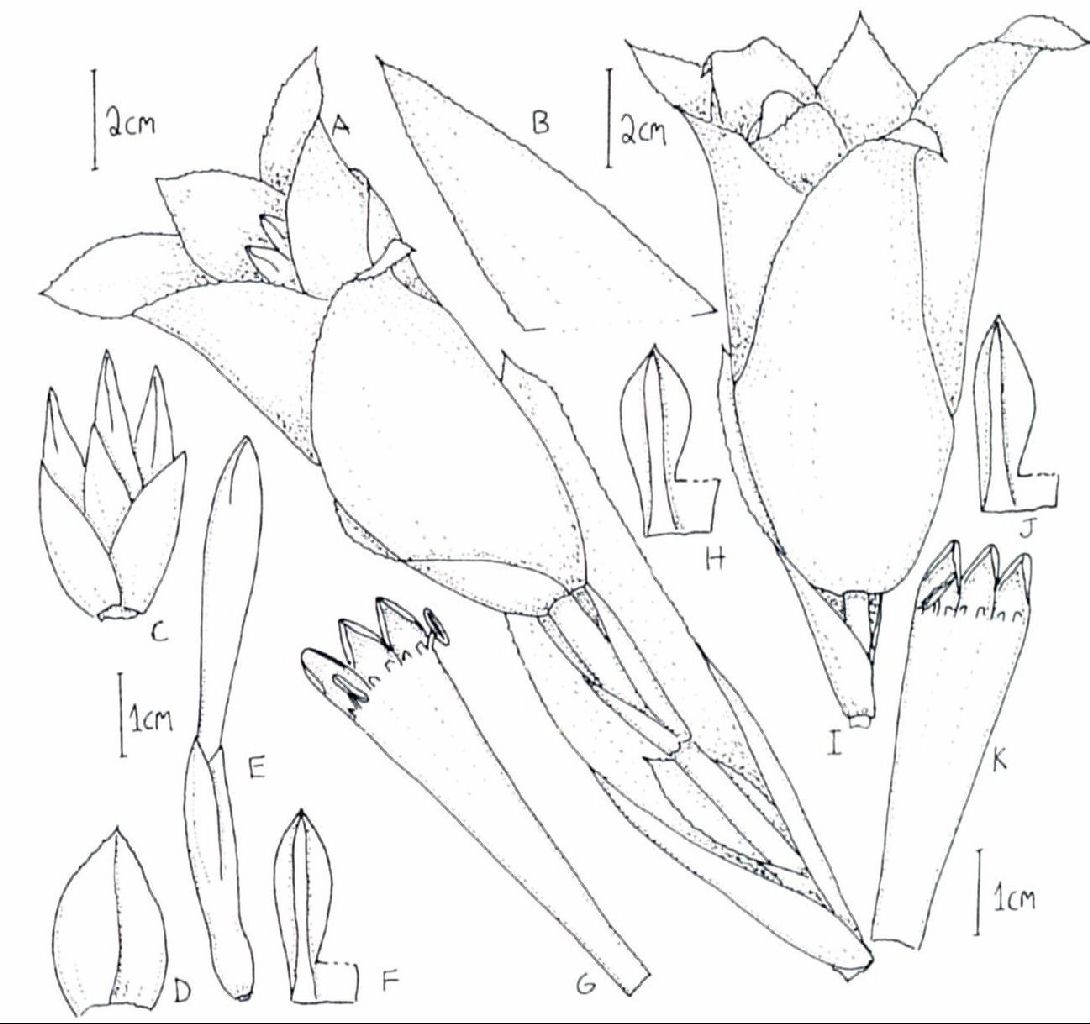Originally as N. innocentii var. wittmackianum, then as Nidularium longiflorum, now as N. innocentii var. paxianum



DD1112
You can thank Kiwi, Peter Waters for this. He is a regular viewer of the Bromeliads in Australia web site and pointed out the misidentification of photos purporting to be Nidularium longiflorum.
We all know we must keep an eye on Botanists who place species under synonymy with another species and change our labels accordingly. In Nidularium- Brom. Atl. Forest 144-153. 2000 by Elton Leme we saw an in-depth review of this genus and many of us noticed that he had placed N. innocentii var. wittmackianum under N. longiflorum. Many of us had been growing N. innocentii var. wittmackianum for years and here was a chance to write a smaller label. But things did not quite fit. N. longiflorum is said to have an uniutriculate inflorescence. Translated this means a single inflorescence without the usual flowering in the side primary bracts so often seen in ‘ordinary’ Nidularium.
The next question I asked myself was how did our N. innocentii var. wittmackianum get identified as such. Looking at Smith & Downs 1979 it seemed the closest fit.
Key to Varieties of Nidularium innocentii
1. Leaves dark red beneath or on both sides; primary bracts red or with the apex green. --> var innocentii.
l. Leaves, or at least their blades, green. --> 2
2. Primary bracts wholly or mostly red-purple. --> 3
2. Primary bracts red near the apex and green elsewhere. --> 4
3. Leaf-blades wholly green. --> var wittmackianum.
3. Leaf-blades marked with longitudinal white lines. --> var striatum.
4. Leaf-blades with numerous longitudinal white lines. --> var lineatum.
4. Leaf-blades with a single large median white stripe. --> var paxianum.
These days you can get access to original descriptions via the internet and I find it great fun checking up on these. Mez’s original description of N. paxianum in 1895 does not refer to any variegation and yet in Smith & Downs 1979 it clearly states “Leaves with a single large median white stripe”.
If we ignore this part of the description then the plant we used to call ‘wittmackianum’ is very close to N. innocentii var. paxianum.
If we look at Flora ilustrada Catarinense - Bromeliaceas by Raulino Reitz (1983) and translate the Portuguese we also see no reference to a large median white stripe. So where did the stripe come from?
We know that Leme placed this taxon as a synonym of N. innocentii so you can change your labels to this species if it has flowers in fascicles around the central inflorescence. Have a careful look next time. Some may say we have a hybrid here but our plant can be traced back to the days when species were being grown in collections!
What does intrigue me is that Leme in 2000 did not mention the error in Smith & Downs 1979.
Pictures from Bromeliads in Australia.
Originally as N. innocentii var. wittmackianum, then as Nidularium longiflorum, now as N. innocentii var. paxianum



Nidularium longiflorum Ule, Ber. Deutsch. Bot. Ges. 14: 408. 1896
Detail from Leme. Nidularium Atl. Forest 159-164. 2000
PLANT propagating by stolons to 30 cm long, 0.8-1 cm m diameter;
LEAVES 10 to 20, suberect-arcuate, thin in texture, forming a narrow funnelform rosette;
SHEATHS elliptic, 6-13 x 3.5-8 cm, densely brown-lepidote, greenish;
BLADES narrowly lanceolate, distinctly narrowed toward base, 20-40 x 3-5 cm, canaliculate toward base with a slightly thicker median channel, subglabrous, green or seldom purplish-red abaxially, apex acute to acuminate, margins densely to subdensely spinulose, spines ca. 0.5 mm long, 3-5 mm apart.
SCAPE 3-10 cm long, 0.5-0.9 cm in diameter, distinctly shorter than the leaf sheaths;
SCAPE BRACTS the basal ones subfoliaceous and concealing the scape, the upper ones resembling the primary bracts.
INFLORESCENCE subumbellate, bipinnate, obconic-subtubular, uniutriculate, 8-12 cm long, ca, 10cm in diameter at apex, distinctly visible above the leaf sheaths but not notably elevated above the rosette;
PRIMARY BRACTS ovate, acute and apiculate to shortly acuminate, suberect to subspreading at apex, the basal ones 7 -14 x 5-8 cm, red or green toward base and red near apex, lepidote mainly toward the base, densely spinulose toward apex, spines ca. 0.5 mm long.
FASCICLES 3 to 5, the basal ones ca. 35 x 15 mm, 2-to-3-flowered;
FLORAL BRACTS ovate to elliptic, apex acute and apiculate, entire to remotely spinulose at apex, 25-30 x 15 mm, membranaceous, lepidote, to equaling the middle of the sepals, hyaline.
FLOWERS subsessile, 70-90 mm long;
SEPALS 23-27 x 7-9 mm, lobes broadly elliptic to ovate-lanceolate, apex acute and minutely apiculate, connate for (5-) 8-10 mm, green to reddish near the apex, glabrous, ecarinate;
PETALS 60-65 (-80) mm long, highly connate, forming at base a narrow tube ca. 3 mm in diameter, tube white toward base and dark green toward apex, lobes ca. 10 x 6 mm, narrowly ovate, narrowly obtuse-cucullate, white, bearing 2 well developed callosities at base;
ANTHERS 5-6 mm long, base and apex obtuse;
STIGMA subglobose, blades with subentire margins;
OVARY ellipsoid to obovate, subtrigonous, ca. 10 mm long, ca. 5 mm in diameter.
FRUITS narrowly obovate, white, persistent calyx green to red toward apex.
DD0412
Or, more thoughts on ‘Derek the hybrid detective’ DD1112, Nov 2012.
By Derek Butcher April 2013
You can blame this on Eileen Killingley trying to work out how I linked the plant we had been growing for years as N. innocentii var wittmackianum to be really N. innocentii var paxianum because of an error in Flora Neotropica, and thus it is just a Nidularium innocentii sensu Elton Leme. I did get carried away by the fact that N. innocentii var wittmackianum was considered a synonym of N. longiflorum and N. longiflorum had an uni-utriculate inflorescence. Uni-utriculate is a word coined by Elton Leme and I wonder if it has botanical significance. In Leme’s description of N. longiflorum we see ‘INFLORESCENCE subumbellate, bipinnate, obconic-subtubular, uniutriculate,’ and ‘uniutriculate’ can easily be taken out of context. Leme uses two terms, multi-utriculate; flower fascicles more or less evenly distributed along the short inflorescence axis, and uni-utriculate; fascicles concentrated in the central part of the inflorescence. If you are looking at many Nidularium inflorescences you can discern the differences but not if you are only examining one inflorescence. BUT it is clear that uniutriculate does not equate with a simple inflorescence so common in Neoregelia.
I am convinced that N. longiflorum is not in Australia but for a different reason to uni-utriculate. A close look at the following key will show that one main difference is in the well-developed callosities present at the base of the petals for N. longiflorum. In New Zealand they say you look for a uni-utricular inflorescence and white pointed petals for N. longiflorum. I have already pointed out the problem with uniutricular and nowhere in Leme’s description does it refer to pointed petals but says ‘apex narrowly obtuse-cucullate’ for N. longiflorum and ‘apex broadly obtuse-cucullate’ for N. innocentii. Do not get too carried away with the name N. longiflorum which has petals 60-65mm long compared to up to 60mm. for N. innocentii. What I see as the difference to look for is the callosities at the bottom inside of the petals to find your N. longiflorum. So if you do not believe me when I suggest you change the name on your old N. innocentii var. wittmackianum to straight N. innocentii then start butchering a flowering plant and look for those callosities.
Mind you I disagree with Elton Leme’s decision to retain the variegated varieties of N. innocentii because they are only propagated asexually and as such would have been better served as being under the realms of the Bromeliad Cultivar Register
Leme’s key in Nidularium, Brom. of Alt. Forest, 37-40. 2000
46a Plant often propagating by short axillary shoots; inflorescence broadly obconic, rosulate-capitate, multi-utriculate; flower fascicles more or less evenly distributed along the short inflorescence axis; petal lobes oblong, without callosities, apex broadly obtuse-cucullate --> 47a
46b Plant propagating by distinct stolons; inflorescence narrowly obconic to subtubular mainly at base, uni-utriculate; fascicles concentrated in the central part of the inflorescence (except in N. picinguabense); petal lobes narrowly ovate, bearing well-developed callosities at base, apex narrowly obtuse-cucullate --> 51a
47a Leaf sheaths not distinctly nerved; inflorescence tripinnate (basal fascicles 4-to-9-flowered); flowers sessile or subsessile; sepals connate at base for 7-14mm --> 48a
48b Leaf-blade spines ca 05 mm long; sepals elliptic to suborbicular, 8-10mm wide --> 49a
49a Leaves concolorous green or purplish-wine mainly abaxially = innocentii var innocentii (BA, RJ, SP, PR, SC & RS)
49b Leaves green with white or yellow longitudinal lines or bands --> 50a
50a Leaves with white or yellow longitudinal lines 1-3mm wide = innocentii var lineatum (SC)
50b Leaves with white or yellow longitudinal bands over 5mm wide = innocentii var striatum (SC)
51b Stolons 10-30cm long; primary bracts abruptly becoming smaller toward the center of the inflorescence; inflorescence uni-utriculate; sepals connate at base for (5-) 8-10mm; petal lobes white, basal tube green toward the apex = longiflorum (ES, RJ, & SP)
Editor's enquiry...
UD..."callosities"? Is this the plural of "callosity" ?
By "A brom glossary". callosity is defined as 'A thickened or hardened part or protuberance.'
How many, how big, and exactly where ?
Answer..."Ian. Trust you to get technical. The enclosed drawing should help a bit. Note the two separate drawings of petals which are in a tube except for the top little bit where you see the callosities - I hope. You would need a magnifying glass to see them.
